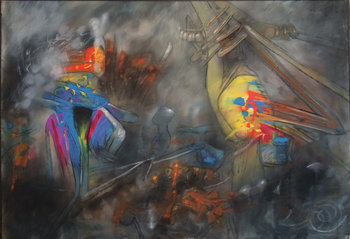
September 18 - November 27, 2024
Volker Stelzmann - Theatrum Mundi
DIE GALERIE, Frankfurt am Main
A brilliant combination of tradition and innovation unfolds before the viewer when contemplating the works of Volker Stelzmann. Once again, we are proud to exhibit the works of the painter, born in Dresden in 1940, who has not only been one of the cornerstones of the gallery program for many years but also one of the most reputable contemporary masters of German figuration. Under the title Theatrum Mundi, we present both early and recent works that reflect the broad spectrum of Stelzmann‘s pictorial cosmos. His virtuoso figurative compositions skillfully blend contemporary themes with veristic style and a mannerist formal structure rooted in the works of Italian Renaissance painters such as Pontormo and Rosso Fiorentino. The characters in Volker Stelzmann‘s painted narratives move as if on a stage, while the artist himself directs the action. Casting a sharp eye on his social environment, he arranges the performers – be they the „acrobats of everyday life“ in the passages and subway tunnels of his Berlin cityscapes, or the acrobats of his „Varieté“. His creations are masterfully orchestrated and appear like snapshots from a multi-layered drama that the artist wraps up with a final brushstroke. Although humans – whether as individuals or as a society – usually take center stage within Stelzmann‘s „world theater“, the artist has also delved into other subjects throughout his now more than 50-year career. Self-reflection in the form of self-portraits has always played a significant role in his oeuvre, as have still lifes and biblical scenes, which testify to his profound knowledge of art history. Volker Stelzmann‘s works provide an unadulterated glimpse into a humanity that is constantly struggling to find a collective identity and continues to search for answers to the existential questions of life without losing itself in the process.


